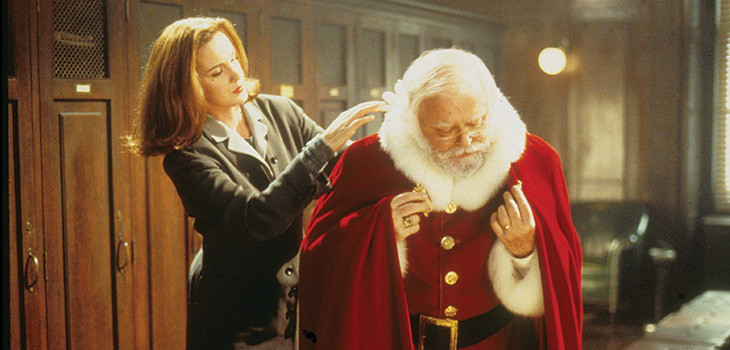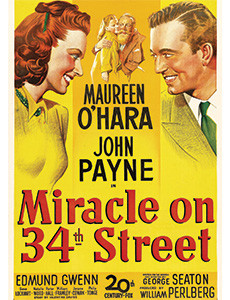*/

David Langwallner’s seasonal choice – two different legal resolutions to the same tough challenge in court
So this is Christmas and what have we done? To misquote John Lennon, a war not over and another begun. Ukraine and Gaza. The level of peace and quiet depicted in Silent Night replaced by a dissonant counterpoint worldwide. Hatred, intolerance and unreason. Criminalising protest and those we disagree with, not to condone recent riots on Dublin’s streets.
For a moment of respite in today’s sturm and drang, we could do worse than turn to A Miracle on 34th Street. Based on a novella by Valentine Davies, released along with the 1947 film directed and screen-written by George Seaton, this popular Christmas comedy-drama is also one for detailed forensic lawyers. It examines, in effect, whether you can prove the existence of Santa Claus.
To take the plot briefly, a young girl (Susan) is taken by her mother’s neighbour, an attorney, to visit Santa at Macy’s department store in New York. Her mother does not like the fact that Kris Kringle, who had been hired to replace another Santa dismissed for drunkenness, tells her daughter that fairy tales can be true. The mother, who as Macy’s events director had actually been instrumental in his appointment, tries to get him dismissed. An investigation takes place into both employment practices and mental states to examine Kringle’s claims to be the real Santa. So, the only way to achieve justice and avoid Kringle’s commitment, is to establish the existence of Santa Claus in a courtroom. A toughie.
Now there are two feature film versions: the classic in 1947 with Maureen O’Hara, John Payne and Edmund Gwenn. The later 1994 incarnation with Elizabeth Perkins, Dylan McDermott and, of course, Sir Richard Attenborough – surely as perfect a Santa as there could possibly be. And two different legal resolutions.
In the 1947 version, an adult and child testify to the existence of Santa Claus. Meanwhile, a good postal worker redirects all letters addressed to Santa, including one from Susan, to the court building. The attorney neighbour, representing Kringle, asserts that the New York Post Office as a branch of the US federal government has asserted his position as the real Santa by delivering the letters to court, thus allowing the politically minded judge to dismiss the case for reputational purposes. Either way, fictional legal evidence for the existence of Santa Claus. In doubt on the civil standard.
The 1994 version, directed by Les Mayfield and produced and co-written by John Hughes, shows an different and unorthodox legal manoeuvre. As the judge is going into court, a dollar bill is handed to him with the words ‘In God we trust’ circled. Thus, legal tender and official recognition that God exists and so must Santa. Case also dismissed.
A greater film for those minded to celebrate Christmas is legendary director Ernst Lubitsch’s The Shop Around the Corner (1940). Two shopworkers (Margaret Sullavan and James Stewart) vehemently do not like each other but come to realise that they do, after unknowingly corresponding with each other.
So, as philosopher Jurgen Habermas suggests, let us rationally communicate and bridge the divide of extremism. Habermas (an atheist, as am I) believes (as do I) that the loss of Christian values has undermined community and society. On this point, Pieter Breughel the Elder’s oil panel ‘The Census at Bethlehem’ (1566) says much. Joseph and Mary, arriving in town as migrants on donkey and trap, with Jesus on his way, are barely noticeable and blend into the scene. Children and adults are at play, drink and food is consumed, work is being done. A community at Christmas.
Happy holidays to all. A time for rest, human compassion, charity and maybe fairy tales. And don’t forget to protect the interests of the ‘little’ people in the courts as he from Lapland fictionally did.


So this is Christmas and what have we done? To misquote John Lennon, a war not over and another begun. Ukraine and Gaza. The level of peace and quiet depicted in Silent Night replaced by a dissonant counterpoint worldwide. Hatred, intolerance and unreason. Criminalising protest and those we disagree with, not to condone recent riots on Dublin’s streets.
For a moment of respite in today’s sturm and drang, we could do worse than turn to A Miracle on 34th Street. Based on a novella by Valentine Davies, released along with the 1947 film directed and screen-written by George Seaton, this popular Christmas comedy-drama is also one for detailed forensic lawyers. It examines, in effect, whether you can prove the existence of Santa Claus.
To take the plot briefly, a young girl (Susan) is taken by her mother’s neighbour, an attorney, to visit Santa at Macy’s department store in New York. Her mother does not like the fact that Kris Kringle, who had been hired to replace another Santa dismissed for drunkenness, tells her daughter that fairy tales can be true. The mother, who as Macy’s events director had actually been instrumental in his appointment, tries to get him dismissed. An investigation takes place into both employment practices and mental states to examine Kringle’s claims to be the real Santa. So, the only way to achieve justice and avoid Kringle’s commitment, is to establish the existence of Santa Claus in a courtroom. A toughie.
Now there are two feature film versions: the classic in 1947 with Maureen O’Hara, John Payne and Edmund Gwenn. The later 1994 incarnation with Elizabeth Perkins, Dylan McDermott and, of course, Sir Richard Attenborough – surely as perfect a Santa as there could possibly be. And two different legal resolutions.
In the 1947 version, an adult and child testify to the existence of Santa Claus. Meanwhile, a good postal worker redirects all letters addressed to Santa, including one from Susan, to the court building. The attorney neighbour, representing Kringle, asserts that the New York Post Office as a branch of the US federal government has asserted his position as the real Santa by delivering the letters to court, thus allowing the politically minded judge to dismiss the case for reputational purposes. Either way, fictional legal evidence for the existence of Santa Claus. In doubt on the civil standard.
The 1994 version, directed by Les Mayfield and produced and co-written by John Hughes, shows an different and unorthodox legal manoeuvre. As the judge is going into court, a dollar bill is handed to him with the words ‘In God we trust’ circled. Thus, legal tender and official recognition that God exists and so must Santa. Case also dismissed.
A greater film for those minded to celebrate Christmas is legendary director Ernst Lubitsch’s The Shop Around the Corner (1940). Two shopworkers (Margaret Sullavan and James Stewart) vehemently do not like each other but come to realise that they do, after unknowingly corresponding with each other.
So, as philosopher Jurgen Habermas suggests, let us rationally communicate and bridge the divide of extremism. Habermas (an atheist, as am I) believes (as do I) that the loss of Christian values has undermined community and society. On this point, Pieter Breughel the Elder’s oil panel ‘The Census at Bethlehem’ (1566) says much. Joseph and Mary, arriving in town as migrants on donkey and trap, with Jesus on his way, are barely noticeable and blend into the scene. Children and adults are at play, drink and food is consumed, work is being done. A community at Christmas.
Happy holidays to all. A time for rest, human compassion, charity and maybe fairy tales. And don’t forget to protect the interests of the ‘little’ people in the courts as he from Lapland fictionally did.

David Langwallner’s seasonal choice – two different legal resolutions to the same tough challenge in court


Chair of the Bar reflects on 2025
AlphaBiolabs has donated £500 to The Christie Charity through its Giving Back initiative, helping to support cancer care, treatment and research across Greater Manchester, Cheshire and further afield
Q&A with criminal barrister Nick Murphy, who moved to New Park Court Chambers on the North Eastern Circuit in search of a better work-life balance
Revolt Cycling in Holborn, London’s first sustainable fitness studio, invites barristers to join the revolution – turning pedal power into clean energy
Rachel Davenport, Co-founder and Director at AlphaBiolabs, reflects on how the company’s Giving Back ethos continues to make a difference to communities across the UK
By Marie Law, Director of Toxicology at AlphaBiolabs
Are you ready for the new way to do tax returns? David Southern KC explains the biggest change since HMRC launched self-assessment more than 30 years ago... and its impact on the Bar
Professor Dominic Regan and Seán Jones KC present their best buys for this holiday season
Oscar Davies shares their lessons learnt
Little has changed since Burns v Burns . Cohabiting couples deserve better than to be left on the blasted heath with the existing witch’s brew for another four decades, argues Christopher Stirling
Pointillism, radical politics and social conscience. Review by Stephen Cragg KC